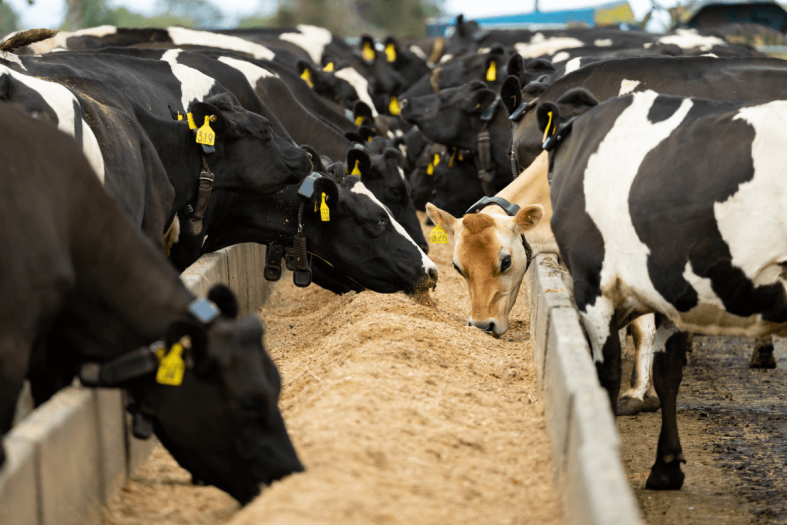
Articles
Feeding maize silage in winter: Setting the herd up for success

As I write this article, temperatures are dropping and a change in weather is signalling that winter is upon us. This will lead to slower pasture growth rates, and with calving not far away, many farmers are turning to maize silage as part of their winter-feeding strategy. While it’s well known for boosting summer and autumn production, maize silage also plays a critical role in winter by helping to build body condition, maintain consistent intakes in poor weather, and support cows through the transition period.
Building Body Condition Score (BCS)
During early winter, the main focus is on BCS. Spring calving cows should now be on a planned nutritional path to achieve BCS targets of 5.5 for younger cows and 5.0 for mature cows. For cows due to calve around mid-July, the window for condition gain typically begins in April and May. From mid- May, a 475kg cow will need to consume around 10 kgDM/day, increasing to 11 kgDM/day by mid- June as pregnancy progresses and maintenance demands increase1.
When you factor in feed utilisation2, this means dry cows should be offered 12–14 kgDM/ day to meet their requirements. In most regions, winter pasture growth rates are modest, and even under favourable conditions, pasture might only supply half of the daily demand. That leaves a gap, which is where maize silage can play a role by providing a consistent energy source to drive efficient BCS gain over the winter months.
Maintaining intake when conditions change
One of the key advantages of incorporating maize silage in winter diets is the ability to maintain drymatter intake when pasture utilisation drops due to poor weather. In good winter grazing conditions, pasture might be utilised at around 80%, but in wet, cold, or muddy conditions, this can easily fall to 70% or lower.
Table 1 illustrates how maize silage offers flexibility in this situation. On a good day, cows may comfortably meet intake targets with 7 kgDM of pasture and 4 kgDM of maize silage to reach an 11 kgDM per cow intake. However, when pasture utilisation drops, the pasture component provides less actual intake, meaning cows fall short of their needs unless additional supplement is introduced.
During poor weather conditions, increasing the amount of maize silage offered by just 1 kgDM ensures that total intake is restored to the target level. Because maize silage is fed in winter on a feedpad, the feeding rate is easy to adjust and less vulnerable to weather-driven losses. This flexibility helps maintain a consistent energy supply when cows need it most.
This approach ensures feed consistency, helps avoid intake dips, and supports continuous progress toward achieving BCS targets.
Table 1: Feeding adjustments to maintain intake during poor weather conditions

Transition feeding and DCAD management
Maize silage also brings significant benefits during the springer period (3 weeks pre-calving). Its low potassium and naturally low DCAD (Dietary Cation-Anion Difference) make it an ideal base for pre-calving diets, particularly when compared to high-potassium pasture (especially from effluent paddocks).
Feeding low-DCAD diets 2–3 weeks before calving improves calcium mobilisation and reduces the risk of milk fever. Maize silage also keeps dietary calcium levels low (<0.5% of DMI), which helps regulate calcium absorption. Once lactation begins and demand skyrockets, cows are better primed to absorb calcium from the diet.
To fully unlock these benefits, it’s important to test feed components and complement the diet with appropriate anionic mineral supplements such as magnesium chloride or sulphate. Your vet or nutritionist can help set appropriate DCAD targets and ensure overall diet balance during this crucial phase.
Feeding maize silage in winter isn’t just about plugging a feed gap; it’s a tool that helps maintain or build body condition, ensures feeding flexibility when pasture utilisation drops, and supports transition into lactation by reducing milk fever risk. While these aren’t new or flashy ideas, they’re fundamental to setting your herd up for a successful calving and productive early lactation.
If you’d like support with feed budgeting, mineral balancing, or getting the most from your maize silage this winter, talk to your nutritionist, vet, or one of the Farm Systems Specialists.
Author, Wade Bell, Pioneer Farm Systems Manager. Published by Rural News 30/05/2025.
1DairyNZ Facts and Figures
2Assume 80% feed utilisation
